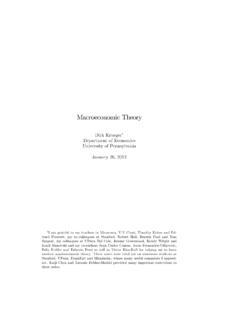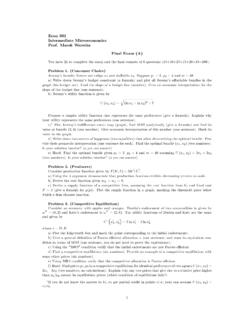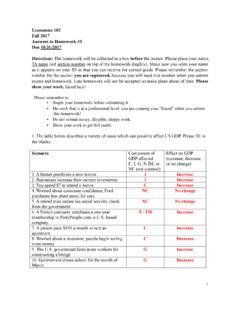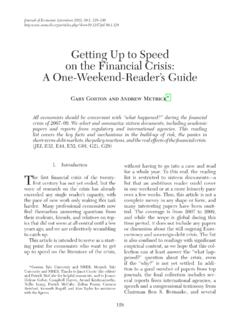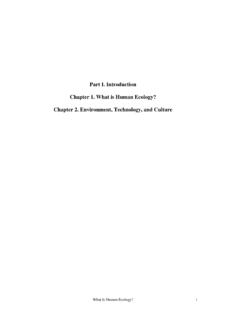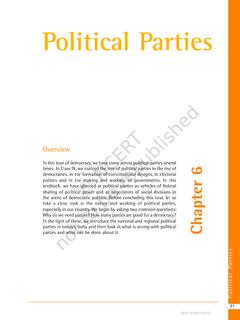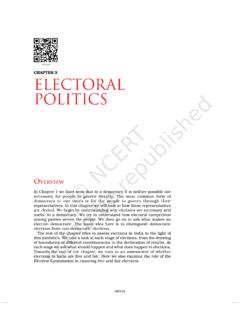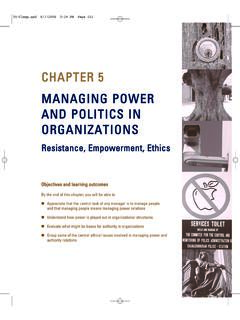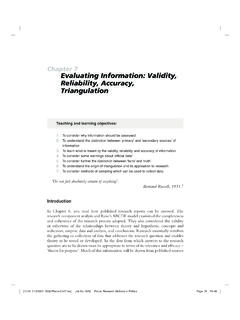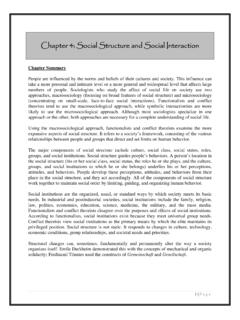Transcription of CHAPTER 14 RACIAL INEQUALITY
1 CHAPTER 14 RACIAL INEQUALITY Final Draft, August 2009 Race and RACIAL INEQUALITY have powerfully shaped American history from its beginnings. Americans like to think of the founding of the American colonies and, later, the United States, as driven by the quest for freedom initially, religious liberty and later political and economic liberty. Yet, from the start, American society was equally founded on brutal forms of domination, INEQUALITY and oppression which involved the absolute denial of freedom for slaves. This is one of the great paradoxes of American history how could the ideals of equality and freedom coexist with slavery? We live with the ramifications of that paradox even today. In this CHAPTER we will explore the nature of RACIAL INEQUALITY in America, both in terms of its historical variations and contemporary realities. We will begin by clarifying precisely what we mean by race, RACIAL INEQUALITY and racism.
2 We will then briefly examine the ways in which racism harms many people within racially dominant groups, not just racially oppressed groups. It might seem a little odd to raise this issue at the beginning of a discussion of RACIAL INEQUALITY , for it is surely the case that RACIAL INEQUALITY is more damaging to the lives of people within the oppressed group. We do this because we feel it is one of the critical complexities of RACIAL INEQUALITY and needs to be part of our understanding even as we focus on the more direct effects of racism. This will be followed by a more extended discussion of the historical variations in the forms of RACIAL INEQUALITY and oppression in the United States. The CHAPTER will conclude with a discussion of the empirical realities today and prospects for the future. This CHAPTER will focus primarily on the experience of RACIAL INEQUALITY of African-Americans, although in the more historical section we will briefly discuss specific forms of RACIAL oppression of Native-Americans, Mexican-Americans, and Chinese-Americans.
3 This focus on African-Americans does not imply that the forms of racism to which other RACIAL minorities have been subjected are any less real. And certainly the nature of RACIAL domination of these other groups has also stamped the character of contemporary American society. WHAT IS RACE? Many people think of races as natural categories reflecting important biological differences across groups of people whose ancestors came from different parts of the world. Since RACIAL classifications are generally hooked to observable physical differences between people, the apparent naturalness of race seems obvious to most people. This conception reflects a fundamental misunderstanding about the nature of RACIAL classifications. Race is a social category, not a biological one. While RACIAL classifications generally use inherited biological traits as criteria for classification, nevertheless how those traits are treated and how they are translated into the categories we call races is defined by social conventions, not by biology.
4 In different times and places RACIAL boundaries are drawn in very different ways. In the a person is considered Black if they have any African ancestry. This extreme form of binary RACIAL classification reflects the so-called one-drop rule that became the standard system of RACIAL classification in the after the Civil War. Imagine how different the meaning of CHAPTER 14. RACIAL INEQUALITY 2 race would be in the US if the one-drop rule were reversed: anyone with any European ancestry would be classified as white. In Brazil, in contrast to the , RACIAL classifications are organized on a more continuous spectrum. In the all East Asians are considered a single RACIAL category; in East Asia, on the other hand, Chinese, Japanese, Koreans and Vietnamese are considered separate races. The United States Immigration Commission in 1911 considered people of Irish, Italian, Polish, and English descent to be distinct races , and the 1924 Immigration Act passed by Congress restricted immigration of what were termed inferior races from Southern and Eastern Europe.
5 In Germany under the Nazis, Jews were considered a distinct race, not merely a religious group or an ethnic group. In Africa today, Tutsi and Hutu have sometimes been regarded as distinct races. RACIAL classifications are thus never simply given by biological descent even if they always invoke biology; they are always constructed through complex historical and cultural processes. RACIAL classifications do not logically imply RACIAL oppression ( a social injustice backed by power). This is how ethnic distinctions are sometimes experienced: to be of Irish or Swedish or Italian descent in America is to share a certain cultural identity, and perhaps to participate in certain cultural practices as well, but this does not imply any forms of oppression involving these categories. Ethnic difference can be just that: differences. RACIAL classifications could in principle be simply a way of noting physical differences of various sorts that are linked to biological descent.
6 However, in practice RACIAL classifications are almost always linked to forms of unjust economic and social INEQUALITY , domination, and exclusion, as well as to belief systems that assign superior and inferior statuses and attributes according to race. Indeed, as a sociological generalization we can say that RACIAL classifications become salient in people s lives primarily to the extent that they are linked to forms of socioeconomic INEQUALITY and The term racism designates this intersection of RACIAL classification with RACISM AND THE LIVES OF WHITE AMERICANS To study race in American society, then, is to investigate the ways in which RACIAL classifications are linked to historically variable forms of oppression. The moral core of such an analysis is understanding the ways in which RACIAL oppression imposes harms on people in the racially oppressed category. Nevertheless it is a mistake to think of racism as something that only affects the lives of African Americans, Native Americans, Asian Americans, Latinos and other racially defined minorities.
7 Racism has profoundly shaped American society and politics in ways that deeply affect the lives of white Americans as well, particularly the lives of working class and poor whites, not just the lives of minorities. Racism harms disadvantaged groups within the white population in two principle ways. First, racism has repeatedly divided popular social and political movements, undermining their capacity to challenge prevailing forms of power and INEQUALITY . Ruling elites have often used race as part of a strategy of divide and conquer to protect their class interests. Numerous 1 Once a RACIAL category becomes historically rooted and part of the daily lives of people it can also become an ethnicity a category of people with shared historical experience, cultural practices and identities. This adds to the complexity of race as a form of social division.
8 2 The word racism is sometimes used more narrowly to refer simply to beliefs and ideologies that have a racist content. We will use the term in a more encompassing way to include both the social relations and the systems of belief that link forms of socioeconomic injustice to RACIAL classifications. CHAPTER 14. RACIAL INEQUALITY 3 examples can be cited: In the 1880s and 1890s a radical political movement of workers and small farmers the Populists emerged in the Midwest and the South. For a time it appeared that black tenant farmers and small white farmers in the South might be able to make common cause against large landowners and Southern elites. At its height the Populists appeared to pose a potentially serious challenge to the dominant political parties of the period and even to the interests of dominant classes. RACIAL conflict eventually tore apart the agrarian unity of the Populists and contributed to the decline of the movement overall.
9 Throughout the late 19th century and the first part of the twentieth century employers used RACIAL minorities as strike breakers in industrial strikes. This significantly weakened the ability of unions to win strikes, and also contributed to deep resentments against blacks and other minorities within the white working class. In the late 1960s and early 1970s, in response to the civil rights movement, the Republican Party under Nixon adopted what came to be known as the Southern Strategy in which RACIAL fears were deliberately used to get white working class voters to switch political allegiance from the Democrats to the Republicans. This strategy is credited by many scholars with ushering in an era of conservative politics which ultimately significantly harmed the economic interests of white workers by weakening unions, lowering the minimum wage, reducing job security. Research on wage INEQUALITY has demonstrated that in those cities and regions of the United States where the black/white wage difference is the greatest it is also the case that the wages of white workers are the lowest and INEQUALITY among whites is What this suggests is that RACIAL divisions within the working class weaken the ability of workers as a whole to bargain higher wages with their employers.
10 White workers, in the long run, would be better off economically if there was less INEQUALITY and more solidarity between white and black workers. In the absence of RACIAL divisions and RACIAL conflict, popular social forces would in general have been stronger, more capable of influencing political parties and challenging dominant class interests. The second way that racism has negatively affected the interests of less advantaged segments of the white population is through the ways it has undermined universalistic aspects of the welfare state. Universal programs are programs that apply to all people. They are contrasted with targeted programs that apply only to special, designated groups. In general, as we noted in our discussion of poverty, universalistic programs tend to be better funded than targeted programs and to more robustly improve the conditions of life of people at the bottom of the class structure.


